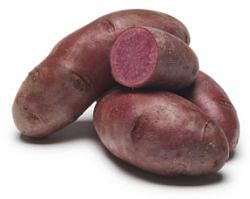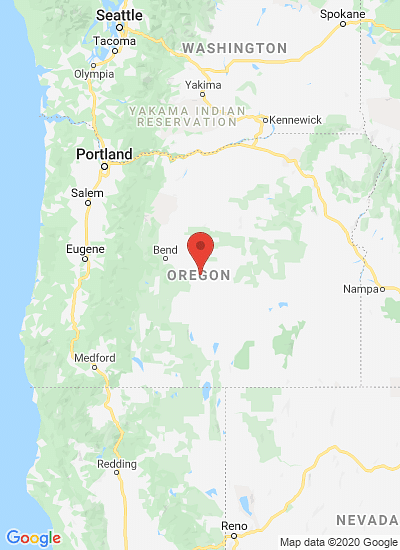Oregon State University
AmaRosa and Sage Russet released by Oregon State University

Two new potato varieties just released by Oregon State University are likely to catch the eye of Oregon's potato processing industry and the gourmet market.
A red fingerling called 'AmaRosa' is likely to be popular with the upscale potato specialty market, said Solomon Yilma of the OSU breeding program. A small fingerling potato with smooth, deep-red skin, AmaRosa has red flesh also and when sliced looks like pepperoni. The tasty tubers retain their color even as they are baked, fried or cooked in the microwave."

Amarosa
"AmaRosa tubers are also loaded with high level of antioxidants,"Yilma said.
The fingerling potatoes are smaller than others and pack easily. They also are resistant to scab, a harmless but unsightly bump on the skin that can make them less marketable. "In fact, AmaRosa could become popular with organic growers because it resists both scab and tuber late blight,"Yilma said.
The other potato variety, the light-brown 'Sage Russet,' can help supply the needs of the Oregon market for processed potatoes.

Sage Russet
The flattened, long shape of Sage Russet makes it the right size to slice and freeze as French fries for commercial and home use. Seventy-five percent of Oregon potatoes are made into food products such as frozen shoestring fries for fast food restaurants, hash browns and chips, and nearly 25 percent of all French fries exported from the United States come from Oregon, according to the Oregon Potato Commission.
"Visual defects can be a problem for the consumer, but Sage Russet has minimal internal flaws,"Yilma said. "Its eyes are evenly distributed and lack distinctive 'eyebrows' — tiny scars left by leaves."When dropped into hot oil, the fries keep their light color because of their low sugar levels.
Sage Russet also is suitable to sell fresh, and as it was evaluated during breeding trials, it earned high scores in yields, high protein content and vitamin C.
Potato breeding can take 10 to 15 years, and Sage Russet began with a cross made in 1996, Yilma said. It was grown and selected over the years for qualities such as storage time, high yields, taste, nutritional content and disease resistance.
The tubers go through a vigorous evaluation system that begins in Oregon with Tri-State trials that eventually include Idaho and Washington;the first trials for Sage Russet were in Powell Butte, Hermiston, Klamath and Ontario, Oregon. The evaluation process ends with Western Regional trials in California, Colorado and Texas.
Plant Variety Protection, an intellectual property statute that gives breeders up to 25 years of exclusive control of propagation, will be filed for Sage Russet and AmaRosa. The potato varieties will be licensed to the Potato Variety Management Institute, a nonprofit organization that works on behalf of the Tri-State Potato Breeding Program. Disease-free small tubers grown from tissue culture are available from the University of Idaho Tissue Culture Laboratory.
Breeding of AmaRosa began with a cross made in 2000 and was selected from seedlings planted at Madras, Ore. in 2001. It went through six years of public trails in the western United States
OSU led the release of AmaRosa and was joined by the experiment stations of Oregon, Idaho and Washington and the USDA Agricultural Research Service.
In 2010, potatoes were the sixth largest agricultural product in Oregon. Growers planted 38,315 acres of potatoes and saw sales of $150.7 million, according to a report by the OSU Extension Service.








